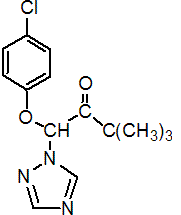|
三唑酮
三唑酮属于低毒性杀菌剂。原药大鼠急性经口LD50为1000-1500毫克/公斤,大鼠经皮LD50>1000毫克/公斤。对皮肤有轻度刺激作用,在试验剂量内无致癌、致畸、致突变作用,对鱼类毒性中等,对蜜蜂和鸟类无害。
triadimefon
其他名称 百理通,粉锈宁,百菌酮,Amiral
分子式 / 分子量 / CAS / EINECS
C14H16ClN3O2 / 293.7 / 43121-43-3 / 256-103-8
特点
病原真菌细胞膜麦角甾醇合成抑制。在病菌体内还原成“三唑醇”而增加了毒力。对卵菌纲的疫霉(不产生麦角甾醇)无效。
是一种具有较强内吸性的杀菌剂,具有双向传导功能,并且具有预防、铲除、治疗和熏蒸作用,持效期较长。
剂型
5%、15%、25%可湿性粉剂,25%、20%、10%乳油,20%糊剂,25%胶悬剂,0.5%、1%、10%粉剂,15%烟雾剂。
适用范围
对锈病、白粉病和黑穗病有特效,对玉米、高粱等黑穗病、玉米圆斑病,具有较好的防治效果。
使用方法
1、麦类黑穗病、锈病、白粉病、云纹病等 麦类黑穗病,100公斤种子拌有效成分30克(15%可湿性粉剂200克)的药剂; 对锈病、白粉病、云纹病可在病害初发时,每亩用有效成分8.75克(25%乳油35克),严重时可用15克有效成分(若用25%乳油,则需60克)兑水75-100公斤喷雾。
2、玉米、高粱丝黑穗病 防治玉米丝黑穗病,每100公斤种子用15%可湿性粉剂533克拌种。 高粱丝黑穗病,每100公斤种子用15%可湿性粉剂266-400克拌种。
3、瓜类白粉病 大田用25%可湿性粉剂5000倍液喷雾1-2次,温室用25%可湿性粉剂1000倍液喷雾1-2次。 菜豆类锈病 可在发病初期或再感染时,用25%可湿性粉剂2000倍液喷1-2次。
注意事项
可与碱性以及铜制剂以外的其他制剂混用。 拌种可能使种子延迟1-2天出苗,但不影响出苗率及后期生长。 药剂置于干燥通风处。 无特效解毒药,只能对症治疗。
作用特点:是一种高效、低毒、低残留、持效期长、内吸性强的三唑类杀菌剂。被植物 的各部分吸收后,能在植物体内传导。对锈病和白粉病具有预防、铲除、治 疗、熏蒸等作用。对多种作物的病害如玉米圆斑病、麦类云纹病、小麦叶枯 病、凤梨黑腐病、玉米丝黑穗病等均有效。对鱼类及鸟类较安全。对蜜蜂和 天敌无害。三唑酮的杀菌机制原理极为复杂,主要是抑制菌体麦角甾醇的生 物合成,因而抑制或干扰菌体附着孢及吸器的发育,菌丝的生长和孢子的形 成。三唑酮对某些病菌在活体中活性很强,但离体效果很差。对菌丝的活性 比对孢子强。三唑酮可以与许多杀菌剂。杀虫剂、除草剂等现混现用。
分子式:C14H16ClN3O2
分子量:293.75
CAS号:43121-43-3
理化性质:无色固体,熔点82-83℃,有特殊芳香味,蒸气压0.02mPa(20℃),0.06mPa (25℃),密度1.22(20℃), KowlogP=3.11,溶解度水64mg/L(20℃),中度溶于 许多有机溶剂,除脂肪烃类以外,二氯甲烷、甲苯>200,异丙醇50-100, 己烷5-10g/L(20℃),酸性或碱性(pH为1-13)条件下都较稳定。 pH3,6,9(22℃)半衰期超过1年。
毒性 中毒症状:一般只对眼睛和皮肤有刺激性。
急救治疗:无中毒报导。对症治疗,误食立即催吐、洗胃。
注意事项:要按规 定用药量使用,否则作物易受药害。
环境 水生生物:LC50(96小时,mg/L)金雅罗鱼13.8,鳟鱼17.4,兰鳃太阳鱼11
蜜蜂:无毒
天敌:急性经口LD50北美鹑>4000mg/kg,LC50(8天,膳食)野鸭>10000,北美鹑>4640
水土保持:半衰期约18天(砂壤土),约6天(壤土),Ko
制备方法
生产方法:
由α-溴代频哪酮与氯酚钠反应生成α-对氯苯氧基频哪酮,然后与溴反应生成α-对氯苯氧基-α-溴代频哪能酮,最后1,2,4-三唑反应生成三唑酮。制得的三唑酮原粉含量在96%以上,该农药剂型主要有20%乳油和15%可湿性粉剂。
制备方法一
1,2,4-三唑的制备 将氨气通入甲酸中制得甲酸铵,再与水合肼进行反应得1,2,4-三唑。
一氯频哪酮的制备异戊醇在活性氧化铝催化下脱水、转位生成异戊烯。2-甲基-1-丁烯和2-甲基-2-丁烯与氯化氢加成生成氯代特戊烷。再在酸性溶液中与甲醛反应生成频哪酮,在溶剂存在下通氯得一氯频哪酮。
三唑酮的合成一氯频哪酮在与对氯苯酚在碳酸钾存在下,在甲苯溶剂中制得1-(4-氯代苯氧基)频哪酮,然后用氯化硫酰氯化制得1-(4-氯代苯氧基)-1-氯代频哪酮。再与1,2,4-三唑合成三唑酮,收率88%。
反应也可在丙酮溶剂中,以碘化钠为催化剂,无水碳酸钾为缚酸剂合成醚酮,再换四氯化碳为溶剂与氯化硫酰反应得到定量收率的α-氯代醚酮,然后重新在丙酮溶剂中与1,2,4-三唑反应合成三唑酮,收率87%。
制备方法二
Stolzer等人于1977年报道,以α,α-二氯频哪酮、对氯酚与1,2,4-三唑在丙酮溶剂中以过量无水碳酸钾作缚酸剂,回流15h后经酸碱处理得产品,收率60%~76.8%。
国内研究的一步法是将α,α-二氯频哪酮、对氯苯酚和1,2,4-三唑一起反应,一步合成三唑酮。采用相转移催化法一步合成三唑酮的工艺过程是:将.29g (10mmol)对氯苯酚、0.9g(13mmol)1,2,4-三唑、3.5g(22.4mmol)粉末状无水碳酸钾、相转移催化剂聚乙二醇(用量5%mol,按对氯苯酚计)和20mL乙酸乙酯,加热,搅拌,滴加1.78g (10mmol)二氯频哪酮溶于10mL乙酸乙酯的溶液,回流反应7.5h,冷却至室温。过滤,依次用稀碱、稀酸和水洗涤至中性,分出油层,无水硫酸镁干燥,减压脱去乙酸乙酯得三唑酮粗品。重结晶后得白色固体,熔点73~76℃。进一步用氧化铝柱色谱法提纯,m.p.80~81℃。使用相转移催化合成产品纯度85%左右,纯品收率82.7%。
制备方法三
在无水碳酸钠存在下、四氯化碳溶剂中,于35℃将1,2,4-三唑通氯氯化,得到1-氯代-1,2,4-三唑,并以此作为氯原子给予体与酮醚反应,使酮醚烷基α位上发生取代反应,生成α-氯代酮醚。此反应必须在偶氮二异丁腈等引发剂存在下方能进行。同时,由氯代三唑产生的三唑从反应溶剂中析出,由于反应生成的三唑本身也是纯酸剂,在反应继续进行过程中有三唑酮生成。在补加三唑或缚酸剂之后,α-氯代酮醚全部反应。
上下游原料:
下游产品:三唑醇-->烯效唑可湿性粉剂
上游产品:甲醇-->甲苯-->碳酸钾-->氯-->甲醛-->水合肼-->甲酸-->氯苯-->磺酰氯-->正戊烷-->乳化剂-->异戊醇-->甲酸铵-->频哪酮-->三甲氧基磷-->4-氯苯酚-->2-甲基-2-丁醇-->乳油-->原粉-->3-甲基-1-丁烯-->分散剂-->2-甲基-2-丁烯-->2-甲基-1-丁烯-->一氯频呐酮-->1,1-二氯频哪酮-->氯酚-->2-丙酮氧基-3,4-二氟硝基苯-->氯代醚酮
|
|
triadimefon
Fungicide
FRAC 3, G1; DMI: triazole

NOMENCLATURE
Common name triadimefon (BSI, E-ISO); triadiméfone ((m) F-ISO)
IUPAC name 1-(4-chlorophenoxy)-3,3-dimethyl-1-(1H-1,2,4-triazol-1-yl)butan-2-one
Chemical Abstracts name 1-(4-chlorophenoxy)-3,3-dimethyl-1-(1H-1,2,4-triazol-1-yl)-2-butanone
CAS RN [43121-43-3] unstated stereochemistry EEC no. 256-103-8 Development codes BAY MEB 6447; BAY 129128; BAYE 8364 (Bayer)
PHYSICAL CHEMISTRY
Composition Racemate (i.e. 1:1 mixture of (1R)- and (1S)- enantiomers). Mol. wt. 293.8 M.f. C14H16ClN3O2 Form Colourless crystals, with a weak characteristic odour. M.p. 82.3 ºC V.p. 0.02 mPa (20 ºC); 0.06 mPa (25 ºC) KOW logP = 3.11 Henry 9 ´ 10-5 Pa m3 mol-1 (20 °C) S.g./density 1.22 (20 °C) Solubility In water 64 mg/l (20 ºC). Moderately soluble in most organic solvents except aliphatics. In dichloromethane, toluene >200, isopropanol 99, hexane 6.3 (all in g/l, 20 ºC). Stability Stable to hydrolysis; DT50 (22 ºC) >1 y (pH 3, 6, and 9).
COMMERCIALISATION
History Fungicide reported by P. E. Frohberger (Mitt. Biol. Bundesanst. Land-Forstwirtsch. Berlin-Dahlem, 1973, 151, 61) and by F. Grewe & K. H. Büchel (ibid., p. 208). Introduced by Bayer AG and first marketed in 1976. Patents BE 793867; US 3912752 Manufacturers Bayer CropScience
APPLICATIONS
Biochemistry Steroid demethylation (ergosterol biosynthesis) inhibitor. Mode of action Systemic fungicide with protective, curative and eradicant action. Absorbed by the roots and leaves, with ready translocation in young growing tissues, but less ready translocation in older, woody tissues. Uses Control of powdery mildews in cereals, pome fruit, stone fruit, berry fruit, vines, hops, cucurbits, tomatoes, vegetables, sugar beet, mangoes, ornamentals, turf, flowers, shrubs and trees; rusts in cereals, pines, coffee, seed grasses, turf, flowers, shrubs and trees; Monilinia spp. in stone fruit; black rot of grapes; leaf blotch, leaf spot, and snow mould in cereals; pineapple disease butt rot in pineapples and sugar cane; leaf spots and flower blights in flowers, shrubs and trees; and many other diseases of turf. Application rates are in the range 0.0025-0.0125% for vegetables, pome fruit, mangoes, and grapes; in the range 125-500 g/ha for cotton, cereals, hops, coffee, and sugar beet. Phytotoxicity Ornamentals may be damaged if triadimefon is used at excessive rates. Formulation types DP; EC; PA; WG; WP. Compatibility Compatible with WP formulations of other pesticides. Selected products: 'Adifon' (Vapco); 'Bayleton' (Bayer CropScience); mixtures: 'Bayleton AN' (+ propineb) (Bayer CropScience); 'Bayleton CA' (+ captan) (Bayer CropScience); 'Bayleton Total' (+ carbendazim) (Bayer CropScience)
OTHER PRODUCTS
'Otria 25' (Probelte); 'Sadifon' (Sanonda) mixtures: 'Folicur BT' (+ tebuconazole) (spray, E Europe) (Bayer CropScience); 'Folicur Top' (+ tebuconazole) (spray, Hungary) (Bayer CropScience); 'Reach' (+ chlorothalonil) (Syngenta) Discontinued products: 'Admiral' * (Bayer)
ANALYSIS
Product analysis by hplc with u.v. detection (CIPAC Handbook, 1985, 1C, 2236; AOAC Methods, 17th Ed., 985.08) or by i.r. spectrometry. Residues of triadimefon and the corresponding alcohol (triadimenol) determined by glc (R. Brennecke, Pflanzenschutz.-Nachr. Bayer (Engl. Ed.), 1984, 37, 68; W. Specht, ibid., 1977, 30, 55; W. Specht & M. Tillkes, ibid., 1980, 33, 61). In drinking water, by glc with NPD (AOAC Methods, 17th Ed., 991.07). Methods for the determination of residues are available from Bayer CropScience.
MAMMALIAN TOXICOLOGY
Reviews FAO/WHO 44, 46 (see part 2 of the Bibliography). Oral Acute oral LD50 for rats and mice c. 1000, rabbits 250-500, dogs >500 mg/kg. Skin and eye Acute percutaneous LD50 for rats >5000 mg/kg. Mildly irritating to eyes and skin (rabbits). Inhalation LC50 (4 h) for rats 3.27 mg/l air (dust), >0.5 mg/l (air). NOEL (2 y) for rats 300, for mice 50, for dogs 330 mg/kg diet. ADI (JMPR) 0.03 mg/kg b.w. [1985]. Toxicity class WHO (a.i.) III; EPA (formulation) III EC classification Xn; R22| N; R51, R53
ECOTOXICOLOGY
Birds Acute oral LD50 for mallard ducks >4000 mg/kg. Dietary LC50 (5 d) for mallard ducks >10 000, bobwhite quail >4640 mg/kg diet. Fish LC50 (96 h) for bluegill sunfish 11, orfe 13.8, rainbow trout 17.4 mg/l. Daphnia LC50 (48 h) 11.3 mg/l. Algae ErC50 for Scenedesmus subspicatus 1.71 mg/l. Bees LD50 (contact) >100 mg/bee.
ENVIRONMENTAL FATE
Animals In mammals, following oral administration, 83-96% is excreted unchanged in the urine and faeces within 2 to 3 d. However, metabolism occurs in the liver, mostly to triadimenol (q.v.) and its glucuronic acid conjugates. Half-life in blood plasma is c. 2.5 h. Plants In plants, the carbonyl group is reduced to a hydroxyl group, with the formation of triadimenol (q.v.). Soil/Environment In soil, the carbonyl group is reduced to a hydroxyl group, with the formation of triadimenol (q.v.). DT50 of triadimefon in sandy loam c. 18 d, in loam c. 6 d. Koc 300.
|